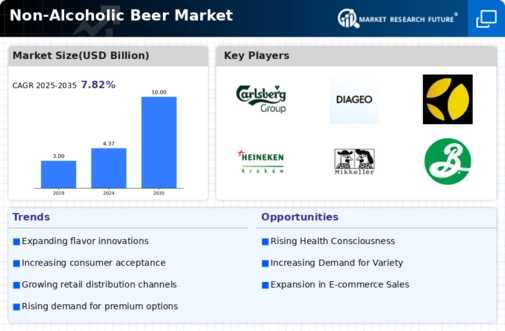Non Alcoholic Beer Market Summary
As per Market Research Future Analysis, the Global Non-Alcoholic Beer Market was valued at 19.87 USD Billion in 2024 and is projected to reach 43.72 USD Billion by 2035, growing at a CAGR of 7.43% from 2025 to 2035. The market is driven by rising health consciousness among consumers, increasing demand for non-alcoholic beverages, and the expansion of distribution channels. Key players are innovating to meet the evolving preferences of health-conscious consumers, leading to a diverse range of product offerings.
Key Market Trends & Highlights
The non-alcoholic beer market is witnessing significant trends driven by consumer preferences and health awareness.
- 36% of individuals aged 18-34 are actively seeking healthier beverage alternatives over the past five years.
- 25% of adults in the European Union are reducing their alcohol intake or abstaining entirely.
- 40% increase in shelf space for non-alcoholic options in grocery and convenience stores worldwide over the last three years.
- New product launches in the non-alcoholic segment have increased by over 50% in the past two years.
Market Size & Forecast
| 2024 Market Size | USD 19.87 Billion |
| 2035 Market Size | USD 43.72 Billion |
| CAGR (2025-2035) | 7.43% |
Major Players
Key companies include Carlsberg, AnheuserBusch InBev, Boston Beer Company, Ambev, Molson Coors Beverage Company, Fallen Brewing Co, Thornbridge Brewery, Kirin Brewery Company, Asahi Group Holdings, Diageo, Deschutes Brewery, Heineken, and BrewDog.




















Leave a Comment